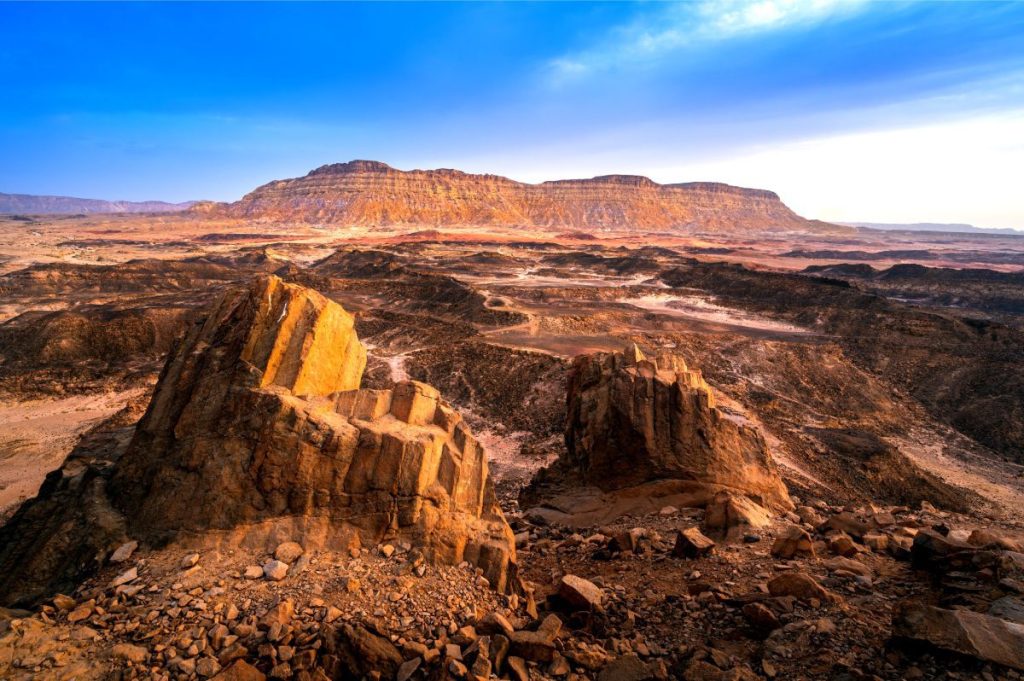The Negev Desert guided tour is my favorite tour to do in Israel! Sadly, not many chose to go there, usually due to lack of time but I would actually allocate at least a full day to spend there. As an Israel private tour guide, I can assure you there are many hidden spots that not many know, but for that, you will need an SUV 4X4.
Did You Know?!
When I give guided tours of Israel, I tell my guests that to survive in the Negev desert, some plants have developed a unique mechanism for optimizing water absorption: It’s done by a deep root system that can reach the groundwater or by a broad, but shallow root system that allows water to be absorbed from the upper layers of the soil meant to collect the water from the flash floods that hit the area, once or twice every winter.
The Acacia Tree: A Source of Life in the Desert

Other plants have developed a different mechanism for reducing water loss by diminishing the leaves’ surface area; thus reducing the amount of water evaporation; other plants shed their leaves in the summer, or grow leaves in the winter that get smaller in the summer.
I try during my private tours of Israel in the desert to show one example of these kinds of plants. One example is the Acacia trees that are widely spread in the Judean Desert and in the Negev.
Highlights of the Negev Desert Guided Tour
Paying Homage to the Father of the State of Israel
Ben-Gurion is the father of the state of Israel: At 35 years of age, he was elected as secretary of the Histadrut (One of the most powerful institutions back then). In the 1930s, he led the Mapai Political Party. As a result, Ben-Gurion became the de facto leader of the Jewish community in Palestine. In 1946 he headed the World Zionist Organization. Lastly, he was elected prime minister of Israel in May 1948. He finally retired in 1963. For sure, it is a stop you have to do when you’re on the Negev Desert Guided Tour.
David Ben Gurion's Tomb Nature Park

The Ramon Crater (Makhtesh Ramon): A Real Geological Wonder
In the Negev Desert, next to the town of Mitzpe Ramon, there is a geological wonder, unique to the Negev Desert and the Sinai Peninsula. When I give a private tour of the Negev, I like to ask my guests: How do you think this enormous hole in the ground was formed?!
Then the little ones usually are eager to answer first and say: “A meteor!”
So firstly, allow me to clarify, Ramon Crater is not an impact crater from a meteor, nor a volcanic crater formed by a volcanic eruption but the world’s largest Erosion Cirque.
Ramon Crater Nature Reserve

Simply said, the crater was created by the slow and gradual erosion of soft rock layers that were under harder layers of rock. The crater’s center used to be the head of a mountain, the crater’s lips are still facing the top of the mountain that no longer exists, and the mountain’s face has eroded slowly to become a crater.
Which Conditions Do You Need to Form a Makhtesh?
In general, the craters in the Negev are not simply created. We’ll need a combination of several conditions for an erosion crater to be formed: asymmetric anticline; layers of rock, that differ in degree of hardness: top layers of hard rock, such as chalk or dolomite, and below them soft rock layers like sandstone; the downcutting of a river removing the crater’s low-drift basin; and desert climate (Dryness that protects the crater walls from weathering).
How Erosion Craters Are Formed?

Please pay a visit to the Makhtesh Ramon Visitors Center (if you’re without an Israel private guide). It’s about an hour of experience but very cool with some visuals about how the crater was formed. After getting some information, go down to the crater; don’t see it from the top only.
The Crater contains diverse rocks, including clay hills known for their colors and forms. The north-eastern edge of the Makhtesh was once covered by spiral ammonite fossils: ranging from the size of snails to that of tractor wheels – these have been extracted so only smaller fossils can be found today.

